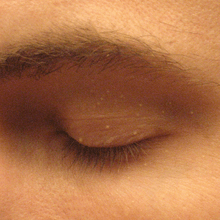Milium (dermatology)
A milium (plural milia), also called a milk spot or an oil seed, is a clog of the eccrine sweat gland. It is a keratin-filled cyst that can appear just under the epidermis or on the roof of the mouth.[1][2]:780 Milia are commonly associated with newborn babies but can appear on people of all ages.[3]:680 They are usually found around the nose and eyes, and sometimes on the genitalia, often mistaken by those affected as warts or other sexually transmitted diseases. Milia can also be confused with stubborn whiteheads.
| Milia | |
|---|---|
 | |
| Milia on the eyelid of an adult male | |
| Specialty | Dermatology |
.jpg)
In children, milia often but not always disappear within two to four weeks. For adults, they can be removed by a physician (a dermatologist will have specialist knowledge in this area). A common method that a dermatologist will use to remove a milium is to nick the skin with a #11 surgical blade and then use a comedone extractor to press the cyst out.[4]
References
- "milium" at Dorland's Medical Dictionary
- Freedberg, et al. (2003). Fitzpatrick's Dermatology in General Medicine. (6th ed.). McGraw-Hill. ISBN 0-07-138076-0.
- James, William D.; Berger, Timothy G.; et al. (2006). Andrews' Diseases of the Skin: Clinical Dermatology. Saunders Elsevier. ISBN 0-7216-2921-0.
- Burnett, Mark E.; Levitt, Jacob O. (2015). "Incision and Drainage (Abscesses, Acne, and Milia)": 119–128. doi:10.1007/978-3-319-13347-8_13. Cite journal requires
|journal=(help)
| Classification | |
|---|---|
| External resources |
| Wikimedia Commons has media related to Milium (disease). |